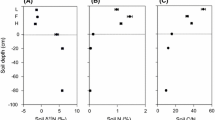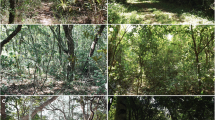Abstract
Functional aspects of biodiversity were investigated in a lowland tropical rainforest in French Guyana (5°2′N, annual precipitation 2200 mm). We assessed leaf δ15N as a presumptive indicator of symbiotic N2 fixation, and leaf and wood cellulose δ13C as an indicator of leaf intrinsic water-use efficiency (CO2 assimilation rate/leaf conductance for water vapour) in dominant trees of 21 species selected for their representativeness in the forest cover, their ecological strategy (pioneers or late successional stage species, shade tolerance) or their potential ability for N2 fixation. Similar measurements were made in trees of native species growing in a nearby plantation after severe perturbation (clear cutting, mechanical soil disturbance). Bulk soil δ15N was spatially quite uniform in the forest (range 3–5‰), whereas average leaf δ15N ranged from −0.3‰ to 3.5‰ in the different species. Three species only, Diplotropis purpurea, Recordoxylon speciosum (Fabaceae), and Sclerolobium melinonii (Caesalpiniaceae), had root bacterial nodules, which was also associated with leaf N concentrations higher than 20 mg g−1. Although nodulated trees displayed significantly lower leaf δ15N values than non-nodulated trees, leaf δ15N did not prove a straightforward indicator of symbiotic fixation, since there was a clear overlap of δ15N values for nodulated and non-nodulated species at the lower end of the δ15N range. Perturbation did not markedly affect the difference δ15Nsoil − δ15Nleaf, and thus the isotopic data provide no evidence of an alteration in the different N acquisition patterns. Extremely large interspecific differences in sunlit leaf δ13C were observed in the forest (average values from −31.4 to −26.7‰), corresponding to intrinsic water-use efficiencies (ratio CO2 assimilation rate/leaf conductance for water vapour) varying over a threefold range. Wood cellulose δ13C was positively related to total leaf δ13C, the former values being 2–3‰ higher than the latter ones. Leaf δ13C was not related to leaf δ15N at either intraspecific or interspecific levels. δ13C of sunlit leaves was highest in shade hemitolerant emergent species and was lower in heliophilic, but also in shade-tolerant species. For a given species, leaf δ13C did not differ between the pristine forest and the disturbed plantation conditions. Our results are not in accord with the concept of existence of functional types of species characterized by common suites of traits underlying niche differentiation; rather, they support the hypothesis that each trait leads to a separate grouping of species.
Similar content being viewed by others
Author information
Authors and Affiliations
Additional information
Received: 18 August 1997 / Accepted: 14 April 1998
Rights and permissions
About this article
Cite this article
Guehl, J., Domenach, A., Bereau, M. et al. Functional diversity in an Amazonian rainforest of French Guyana: a dual isotope approach (δ15N and δ13C). Oecologia 116, 316–330 (1998). https://doi.org/10.1007/s004420050593
Issue Date:
DOI: https://doi.org/10.1007/s004420050593




